Our recent look at Outlaws had me pondering the early days of first-person shooters. The genre as we know it basically started with Wolfenstein 3D in 1992, and then went through a period of rapid advances. We progressed from the flat world of Wolf3d, to the two and a half dimension of Doom, to proper 3D graphics. We saw the first coming of hardware accelerated graphics. Multiplayer options emerged, using local networks and then the internet. There was also a lot of creative thinking, a variety of settings and themes, before the genre became dominated by grim-faced soldiers in drab contemporary battlefields or second world war settings.
There were a number of gems in these formative years, and I thought I’d list some of the ones I personally regard mostly highly. I’ve placed the upper boundary for this period at Half Life, which through features like scripting and set-piece battles really set a whole new standard for implementing a narrative in a first-person shooter. So this is a list of the highlights up until that landmark. All of them except for System Shock, because I bang on about that one enough as it is.
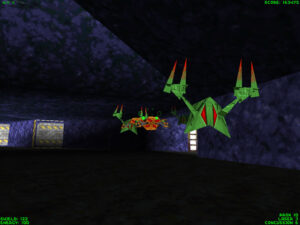
This one put you in the controls of a little spaceship, fighting killer robots through a series of mines across the solar system. Notable for being one of the first of these games to be true 3D in all aspects. So while most games of this era used sprites for their enemies, this one used polygons. Okay, to be fair, they’re fairly simple arrangements of blocks and wedges. Also though the level geometry is fully three dimensional, as opposed to the 2D sketch with bits raised and lowered that Doom used. So you can have one floor under another. Finally, your ship has six degrees of freedom of motion The setup could lead to some confused spinning around and bumping into walls at first, but with a bit of practise you could be strafing around giant chasms and hurtling down tunnels hammering robots with your plasmaguns. Actually it may have been easier to control with the mouse; for some reason I never really tried.
Also memorable for the frantic escape sequence at the end of each level, where you have about half a minute to find an exit before the reactor blows, with much swearing and panic along the way if you didn’t memorise the route ahead of time.
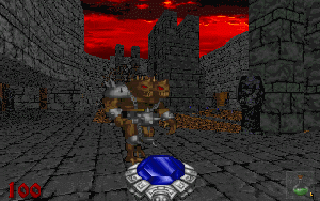
Raven’s first game to use the Doom engine, Heretic, was basically the same game with new levels and the chainguns replaced with magic wands. Fun but not worth a place on the list. Their second attempt however came with a bunch of new ideas. Firstly there are three playable characters, each with their own set of weapons. The warrior is a close range brawler – unusual for the first-person gaming. The more fragile mage likes to fight stuff at long range. The Cleric is somewhere in between and also has a rather ridiculously powerful weapon that basically launches angry ghosts.
Also, levels are now grouped around hubs, allowing you to move back and forth between them. To complete each set of levels you must solve puzzles, usually based on switches or finding items, to open up new sections, until you reach the final conclusion. The puzzles could get a bit frustrating – you’d often hit a button, see a text message telling you “a door has opened in the 7 portals”, and you then spend half an hour trying to figure out where. Still this aspect added some depth to the standard Doom template; there was a bit more to it all than just shooting monsters and gathering keys.
Doom came out around the same time as System Shock, and I sometimes see the two as having been in a competition where the superior title lost. Shock was the slower paced, more intelligent one of the two. It made more of an attempt a story, and had more emphasis on exploring and interacting with the environment around you. It also featured a more advanced game engine with features like sloping walls. Yet Doom, with its minimalist run and gun approach was the more successful, and the one the followers in the genre looked to. That’s why spent several years calling them all “doom clones”.
Except, I wasn’t meant to be talking about Shock today. So let me take off my Looking Glass Fanboy goggles, Doom was successful for damn good reasons. Picking it up to play nowadays, the action still feels perfectly tuned. You have the fast, fluid motion, circle strafing and ducking in and out of cover as you battle dozens of imps and demons. The shotgun is somehow still the greatest of its kind in gaming to date. The braying hell barons and tomato-monster Cacodemons are iconic foes. The maps are still creepy and ominous. Sometimes you don’t need anything more chin-strokingly clever than that, just fighting through waves of hellspawn to the The soundtrack is basically a tribute to Slayer and Pantera rendered in midi. Then there’s the masses of user-made levels and total conversions to consider, which along with the multiplayer greatly prolonged the game’s active life amongst shooter fans.
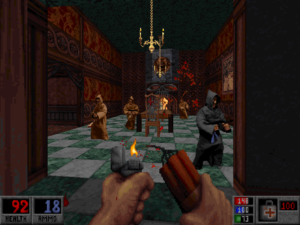
I kind of feel bad for not putting Duke Nukem3D on this list. Really, I’m just more familiar with Blood, which used the same Build engine, and draws on horror movie themes the same way Duke was a tribute to action heroes. Our shadowy protagonist, caleb, starts the game literally rising from the grave, and must kill his way through all kinds of crazed cultists and horrible monsters, to find out why he was put there in the first place. It’s a game with a sense of humour, not afraid to throw in obvious movie references, and a stream of raspy-voiced one liners. Also, the game represents a time when levels were moving from the rather abstract corridors and rooms of Doom, to locations that look like they have an identifiable purpose, and thus feel more convincing. So here we have a train station, a carnival and a hotel that’s basically that one out of the Shining.
Blood was technically out of date at the time; it was one of the last not-quite-3D shooters at a time when Quake had called in a new era of actual 3D. Yet between the memorable maps, the outlandish and macabre themes, and the fun of setting monsters on fire with a flare gun, it more than compensated.
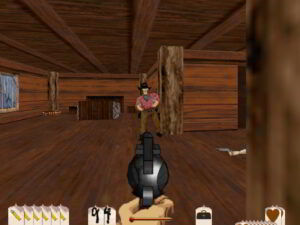
I’d never played this before our recent article, but it’s shot straight onto my list of favourites. It’s very much a pre-half-life, mid 90s shooter at heart – you sprint around shooting lots of fairly dimwitted goons in the face. Yet it has its own feel; you can die shockingly fast if you start taking hits, but there are no bullet sponge enemies either – they’re desperados, not cyberdemons. So the emphasis is on, suitably enough, being quick on the draw. Fast, accurate reactions are required.
Like Blood and Duke3d, the game manages some realistic looking maps despite being based on an old-fashioned engine. There’s sawmill, a fort and a small town with all the expected features like saloon and mortuary. Meanwhile, if you’re a fan of the old Spaghetti westerns, the music and artwork will make you feel right at home. The intro is something straight out of the Dollars trilogy. Meanwhile the animated cutscenes still look great, basically of the same standard that Lucasarts produced with their adventures of the time such as Sam and Max.
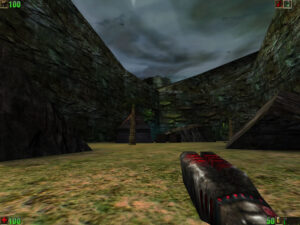
Perhaps the first shooter that truly showed me the benefits of the new generation of hardware-accelerated 3D graphics. The Quake series was technically advanced yet also relentlessly drab. Unreal however looked incredible – that first scene where you emerge from a crashed spaceship, into a verdant tropical paradise, is unforgettable. Looking back Unreal was a bit unsatisfying in some ways, particularly the weapons which felt more like colourful lightshows than anything substantial. Yet it’s exotic, alien, slight dreamlike world marks it as a highlight of this era.

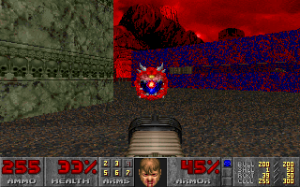

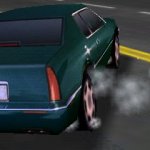
 Posts
Posts
You forgot Klingon Honor Guard.
November 29, 2015 @ 10:26 pm
A glaring oversight! I do actually want to try it sometime.
December 1, 2015 @ 3:17 pm
Long time reader of your works, I dare to submit a comment..
In France (boooh froggies), Klingon Honor Guard was poorly received by the gaming press. I tried the demo at that time, and, not being a trekkie, I can’t say I bought into that crap. 🙂
I found Jedi Knight to be much more appealing.
December 13, 2015 @ 1:05 pm
Hi Nicouse!
I admit to moderate sarcasm regarding Klingon Honor Guard – a bit of a long-running joke between me and my colleague here.
I don’t think it was well received in the UK gaming press either, although bizarrely our magazine of choice at the time (PC Zone) gave it an absurdly high mark.
[Edit: searching for evidence of this review I came across a letter to the magazine describing it as ‘Klingon Bollocks Guard’.]
December 15, 2015 @ 1:49 pm
Ooops I didn’t catch the irony. But how could it be otherwise indeed ? 🙂
If I recall correctly, but I couldn’t check, the lead PC magazine in France, Joystick, gave it a 35%, and reviewed it in just a few lines. Surprisingly its rating is not so bad on Mobygames or Metacritic…
I’m gladly suprised you put Hexen in this list. I’ve been playing it again and again for the past few years (never completed it though) and I feel it was totally overlooked. A gem history of video games has forgotten about.
I agree with your comment about Quake in the Unreal section (who at that time hasn’t been astonished by the first outdoor scenery at NyLeve’s Falls when coming out from the Vortex Rikers. It was just jaw-dropping). However, I felt the promise fell short after that and the lava level, as you suggest by the way.
I also can understand why you didn’t put Quake in the list though. One’s had to be receptive to the gloomy architecture, the ambient sounds and especially the atmospheric yet creepy soundtrack. 20 years later I still listened to it from time to time. Apart from the technical viewpoint of the 3D engine, it was certainly the greatest accomplishment of Quake. And let’s not forget about the wonderful storyline…hem… :-p
In the Duke vs Quake, I was gained to the cause of the 2nd one. But it was a time when I bought the first 3Dfx and I had the GLQuake demo run hundred of times and was so hypnotized, where DN3D was just software accelerated. Even if I had to admit that in multiplayer the latter was way more fun. In single player, I bought into Quake due to my lovecraftian background.
December 20, 2015 @ 1:58 pm
I’m normally a big fan of gloomy and creepy but Quake never really worked for me, alas. I was always more a Duke fan. Just my subjective opinion, of course.
Hexen is probably my second favourite of the early days, after System Shock.
December 23, 2015 @ 3:11 pm
Adds Dark Forces, Deus Ex, Corridor 7, Strife, William Shatners Tekwar, Shogo, Inferno to the list of omitted titles
January 2, 2016 @ 10:10 pm
Deus Ex doesn’t meet the pre half life criteria! Dark forces I should have included maybe. Strife I haven’t played yet but it’s high priority on my to-do list.
January 5, 2016 @ 4:41 pm